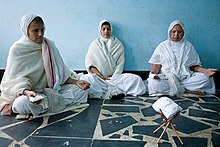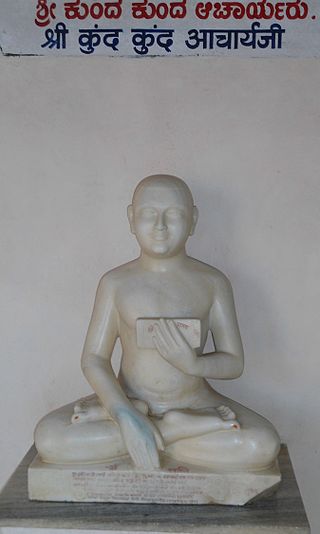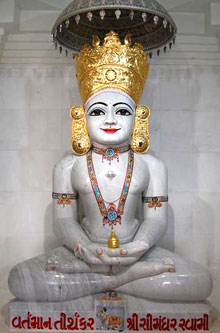
Aryika, also known as Sadhvi, is a female mendicant (nun) in Jainism. [1]
Contents
| Part of a series on |
| Jainism |
|---|
 |


Aryika, also known as Sadhvi, is a female mendicant (nun) in Jainism. [1]
| Part of a series on |
| Jainism |
|---|
 |

In the traditional Digambara tradition, a male human being is considered closest to the apex with the potential to achieve liberation, particularly through asceticism. Women must gain karmic merit, to be reborn as man, and only then can they achieve spiritual liberation in the Digambara sect of Jainism. [2] [3] This view is different from the Svetambara sect that believes that women too can achieve liberation from Saṃsāra by being mendicants and through ascetic practices. [3] [4]
According to Svetambara Jain texts, from Kalpasutras onwards, Jainism has had more sadhvis than sadhus (female than male mendicants). In Tapa Gacch of the modern era, the ratio of sadhvis to sadhus (nuns to monks) is about 3.5 to 1. This is much higher, and in contrast to the gender ratio historically observed in Buddhism and Hinduism. [5]
Traditionally, in contrast to Svetambara, the Digambara sect has had far less sadhvis. [6] In contemporary times, some Digambara organizations include sandhvis, but the ratio of sadhvis to sadhus (nuns to monks) has been about 1 to 3. [7]
A Sadhvi, like a Sadhu, enters the mendicant order by making the Five vows: Ahimsa (Non-violence or Non-injury), Satya (Truthfulness), Asteya (Non-stealing), Brahmacharya (Abstinence from sex and sensual pleasures), and Aparigraha (Non-attachment). [8] [9]
Describing the conduct of aryikas, Champat Rai Jain in his book, Sannyāsa Dharma writes:
The aryika does not visit, the house of a layman alone or without purpose. She is allowed a single robe which is to cover her entire body, from head to foot. In all other respects she conducts herself as a saint of the opposite sex. The aryika is not qualified, as such, to aspire for the pandita-pandita death, but she expects to reach it, from a male body, in a subsequent incarnation. The reason for this is to be found in the fact that a female body is not like a male body in all respects, so that salvation is not possible for a female from the female form. Short of this, however, there is no other difference between the two, the male saint and the aryika (nun), and the latter obtains heaven as the result of her asceticism, when, destroying the liability to be reborn in the female form, she appears in the heavenly regions in the male body of a deva (a resident of the heavenly regions). In her subsequent re-birth amongst men she will retain the male sex, and will then be qualified for salvation through the pandita-pandita mode of passage from 'death to Life Eternal in Nirvana. The aryika sits down to take her food, but in other respects follows the rules by which saints of the opposite sex are governed. [10]
Jains supporting the spiritual liberation of womankind note that their conduct is inclusive in such a path: "It is by way of the Three Jewels that one attains moksa. Nowhere in the Agamas is it stated that women are unable to realise these Three Jewels" (the right faith, right knowledge, and right conduct). [11]
Gyanmati Mataji is a Jain nun having the rank of Ganini Pramukha. [12]
This article incorporates text from this source, which is in the public domain .
Jainism, also known as Jain Dharma, is an Indian religion. Jainism traces its spiritual ideas and history through the succession of twenty-four tirthankaras, with the first in the current time cycle being Rishabhadeva, whom the tradition holds to have lived millions of years ago, the twenty-third tirthankara Parshvanatha, whom historians date to the 9th century BCE, and the twenty-fourth tirthankara Mahavira, around 600 BCE. Jainism is considered an eternal dharma with the tirthankaras guiding every time cycle of the cosmology. The three main pillars of Jainism are ahiṃsā (non-violence), anekāntavāda (non-absolutism), and aparigraha (asceticism).

Mahavira, also known as Vardhamana, was the 24th tirthankara of Jainism. He was the spiritual successor of the 23rd tirthankara Parshvanatha. Mahavira was born in the early part of the 6th century BCE into a royal Kshatriya family in ancient India. His mother's name was Trishala and his father's name was Siddhartha. They were lay devotees of Parshvanatha. Mahavira abandoned all worldly possessions at the age of about 30 and left home in pursuit of spiritual awakening, becoming an ascetic. Mahavira practiced intense meditation and severe austerities for twelve and a half years, after which he attained Kevala Jnana (omniscience). He preached for 30 years and attained Moksha (liberation) in the 6th century BCE, although the year varies by sect.

The Śvētāmbara is one of the two main branches of Jainism, the other being the Digambara. Śvētāmbara means "white-clad", and refers to its ascetics' practice of wearing white clothes, which sets it apart from the Digambara "sky-clad" Jains, whose ascetic practitioners go nude. Śvētāmbaras do not believe that ascetics must practice nudity.

Sadhu, also spelled saddhu, is a religious ascetic, mendicant or any holy person in Hinduism, Buddhism, and Jainism who has renounced the worldly life. They are sometimes alternatively referred to as yogi, sannyasi or vairagi.

Parshvanatha, also Pārśvanātha, Parshva, Pārśva and Parasnath, was the 23rd of 24 Tirthankaras of Jainism. He is the only Tirthankara who gained the title of Kalīkālkalpataru.

Buddhism and Jainism are two Indian religions that developed in Magadha (Bihar) and continue to thrive in the modern age. Gautama Buddha and Mahavira are generally accepted as contemporaries. Jainism and Buddhism share many features, terminology and ethical principles, but emphasize them differently. Both are śramaṇa ascetic traditions that believe it is possible to attain liberation from the cycle of rebirths and deaths (samsara) through spiritual and ethical disciplines. They differ in some core doctrines such as those on asceticism, Middle Way versus Anekantavada, and self versus not-self.

Sallekhana, also known as samlehna, santhara, samadhi-marana or sanyasana-marana, is a supplementary vow to the ethical code of conduct of Jainism. It is the religious practice of voluntarily fasting to death by gradually reducing the intake of food and liquids. It is viewed in Jainism as the thinning of human passions and the body, and another means of destroying rebirth-influencing karma by withdrawing all physical and mental activities. It is not considered a suicide by Jain scholars because it is not an act of passion, nor does it employ poisons or weapons. After the sallekhana vow, the ritual preparation and practice can extend into years.

Jain monasticism refers to the order of monks and nuns in the Jain community and can be divided into two major denominations: the Digambara and the Śvētāmbara. The monastic practices of the two major sects vary greatly, but the major principles of both are identical. Five mahāvratas, from Mahavira's teachings, are followed by all Jain ascetics. Historians believe that a united Jain sangha (community) existed before 367 BCE, about 160 years after the moksha (liberation) of Mahavira. The community then gradually divided into the major denominations.
In Jainism, Sangha is a term used to refer to the fourfold community of Muni, Aryika / Sadhvi, Śrāvaka (laymen), and Śrāvikā (laywomen).

Mūrtipūjaka, also known as Derāvāsī ("temple-dweller") or Mandir Mārgī, is the largest sect of Śvetāmbara Jainism. Mūrtipūjaka Jains differ from both Śvetāmbara Sthānakavāsī and Śvetāmbara Terāpanthī Jains in that they worship images of the Tīrthaṅkaras. Mūrtipūjaka may also generally describe members of both the Śvetāmbara and Digambara traditions who use idols (mūrti) in their worship (pūjā).
Jainism is a religion founded in ancient India. Jains trace their history through twenty-four tirthankara and revere Rishabhanatha as the first tirthankara. The last two tirthankara, the 23rd tirthankara Parshvanatha and the 24th tirthankara Mahavira are considered historical figures. According to Jain texts, the 22nd tirthankara Neminatha lived about 5,000 years ago and was the cousin of Krishna.
Kevala jnana or Kevala gyana, also known as Kaivalya, means omniscience in Jainism and is roughly translated as complete understanding or supreme wisdom.
Mulachara is a Jain text composed by Acharya Vattakera of the Digambara tradition, around 150 CE. Mulachara discusses anagara-dharma – the conduct of a Digambara monk. It consists twelve chapters and 1,243 verses on. It is also called Digambara Acharanga.
Jain literature refers to the literature of the Jain religion. It is a vast and ancient literary tradition, which was initially transmitted orally. The oldest surviving material is contained in the canonical Jain Agamas, which are written in Ardhamagadhi, a Prakrit language. Various commentaries were written on these canonical texts by later Jain monks. Later works were also written in other languages, like Sanskrit and Maharashtri Prakrit.

Digambara is one of the two major schools of Jainism, the other being Śvētāmbara (white-clad). The Sanskrit word Digambara means "sky-clad", referring to their traditional monastic practice of neither possessing nor wearing any clothes.

Jainism is an Indian religion which is traditionally believed to be propagated by twenty-four spiritual teachers known as tirthankara. Broadly, Jainism is divided into two major schools of thought, Digambara and Svetambara. These are further divided into different sub-sects and traditions. While there are differences in practices, the core philosophy and main principles of each sect is the same.
Jainism and Hinduism are two ancient Indian religions. There are some similarities and differences between the two religions. Temples, gods, rituals, fasts and other religious components of Jainism are different from those of Hinduism.

Champat Rai Jain was a Digambara Jain born in Delhi and who studied and practised law in England. He became an influential Jainism scholar and comparative religion writer between 1910s and 1930s who translated and interpreted Digambara texts. In early 1920s, he became religiously active in India and published essays and articles defending Jainism against misrepresentations by colonial era Christian missionaries, contrasting Jainism and Christianity. He founded Akhil Bharatvarsiya Digambara Jain Parisad in 1923 with the aim of activist reforms and uniting the south Indian and north Indian Digambara community. He visited various European countries to give lectures on Jainism. He was conferred with the title Vidya-Varidhi by Bharata Dharma Mahamandal.
Jain law or Jaina law is the modern interpretation of ancient Jain law that consists of rules for adoption, marriage, succession and death prescribed for the followers of Jainism.
Jains are broadly divided into 2 major groups. These include the Digambara, whose clothing displays symbols of cardinal directions, and the Svetambara who wear white clothes. Both of the groups are similar in their ideology but differ in some aspects.